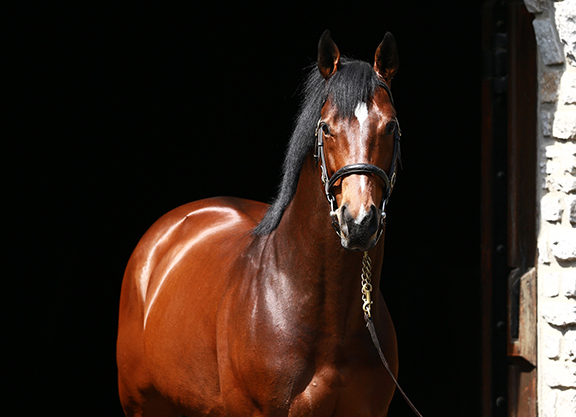By Chris McGrath
He bestrode a century–the American century, as it is often called, and his was certainly a classic American story. Fred W. Hooper, Georgia farm boy, was born in 1897; and died, construction tycoon and member of the Jockey Club, aged 102 in 2000. In his youth he tried his hand as barber, prizefighter, schoolteacher, riveter and carpenter. He was getting somewhere as a potato farmer, until a blight wiped him out. Then he put together a labour crew, on borrowed money, to lay some road bases. In the process he laid the foundation to a fortune made in highways, dams, bridges and airports.
One of Hooper's earliest experiments, aged just 14, had been to bring mustangs from Montana to Georgia. He lassoed them in the wild, they kicked him with their forelegs–but he broke them one by one. That touch with a horse revived when, with his growing wealth, he started raising cattle on a 5,000-acre tract of Alabama. He had a half-bred so agile, in turning the cows, that they started running him in matches over half a mile. Touring the south-eastern fair circuit, he won 49 times in 55 starts.
In 1943, Hooper decided to go into Thoroughbreds. He went to Keeneland, and bought a Sir Gallahad colt for $10,200. Not a lot of flesh to him, as Hooper recalled, but a good walk and a smart eye. Named Hoop Jr., he won the Kentucky Derby by six lengths.
In fairness, Hooper had gone into the game like he meant it, spending good money for 20 yearlings in his first three years. But to win the Kentucky Derby with your very first Thoroughbred has inevitably been celebrated as the ultimate example of beginner's luck.
As such, you could hardly seek a better counterfoil for Lookin At Lucky (Smart Strike) than Hooper–whose legacy, on the Turf, was refreshed by the slow-burning Ashford sire's breakout afternoon last weekend.
In March, Accelerate (Lookin At Lucky) had finally ended his sire's maddening wait for a first U.S. Grade I winner when winning the Big 'Cap by five and a half lengths. On Saturday, Accelerate confirmed his graduation into the elite by winning the Gold Cup at Santa Anita, again by daylight. And his sire not only completed the exacta with Dr. Dorr, but also produced Money Multiplier to win the GII Monmouth S. the same afternoon.
Accelerate, at five, belongs to Lookin At Lucky's second crop; Money Multiplier, at six, to his first. The latter had previously contributed to their sire's serial near-misses at the highest level–crowned, last year, when Lookin At Lee finished second in the Kentucky Derby itself–as runner-up in four Grade I races.
As a May 10 foal by a sire born on May 27, it is hardly surprising that Accelerate should give increasing credence to the theory that Lookin At Lucky–much like his sire, Smart Strike (Mr Prospector); and indeed his sire's outstanding son, Curlin (Smart Strike)–might reward more patience and perseverance than invited by his record, whether as a champion juvenile himself or as a prolific 2-year-old sire.
Actually, setting aside his celebrated instant dividends with Hoop Jr., it feels apt that Hooper should loom benignly over both sides of Accelerate's pedigree. For both in his own, self-made career, and in the sheer span of his years, Hooper testified to the virtues of the long haul.
As it happens, after developing her family, Hooper allowed the mare who holds together Accelerate's family tree to slip through his grasp. Smartaire (Quibu {Arg}) was claimed as a 3-year-old, for just $5,000; and was sold seven years later, at a Keeneland breeding stock sale in 1972, to Jim Ryan's Ryehill Farm for $36,000.
The Ryans had seen that she was bred just like the mother of Hooper's Hall of Fame distaffer Susan's Girl (Quadrangle), winner of three championships over five seasons, whose first two dams were by Hooper's stallions Quibu and Olympia. (The latter had become a cornerstone of Hooper's stud, and the toast of all Thoroughbred breeders, after beating a brilliant Quarter Horse named Stella Moore in a 2f match in 1949.)
Smartaire–by Quibu out of an Olympia mare–became Broodmare of the Year in 1979 after consecutive foals Smart Angle (Quadrangle) and Smarten (Cyane) were respectively champion juvenile filly and runner-up in the GI Travers S. (also a triple Grade II winner, 15 times on the board at three).
Smarten, a perennial leading sire in Maryland, proceeded to make an enduring mark on the breed through the champion Canadian runner and producer Classy 'n Smart, dam of Lookin At Lucky's sire Smart Strike.
In 1981, the Ryans sent their outstanding mare to Alydar, and she delivered a daughter named Smart Darlin. She would be sold to Japan at the Ryehill dispersal in 1988, but not before producing Darlin Lindy (Cox's Ridge). This filly won six times before becoming dam of Wagon Limit (Conquistador Cielo), who shocked Gentlemen and Skip Away in the GI Jockey Club Gold Cup-and grand-dam of Accelerate's mother Issues (Awesome Again).
Issues is proving a useful producer, her two GSP foals by Scat Daddy, including GI Breeders' Cup Juvenile Turf third Daddy D T. Hardly surprising, of course, if a son of Deputy Minister like Awesome Again should also turn out to be a strong broodmare sire. But Lookin At Lucky, picked by Accelerate's breeder Mike Abraham, has given her a better runner even than his late Ashford studmate.
Much as did Scat Daddy, Lookin At Lucky has given notice of his true potential as a stallion when shuttling to Chile. He has had four Group 1 winners there, and was champion sire last year. But the fact is that in his homeland, Lookin At Lucky has had to work hard to hold his ground–his fee has halved from an opening $35,000 to $17,500, while his yearling average in 2017 was $60,000–between the “supersires” and those unproven rookies so beloved by the market.
Lookin At Lucky did face one significant challenge when retired to stud–even as the first colt since Spectacular Bid to back up Eclipse Awards as two and three. For in contrast with the respectable Victorian lady, he would always get himself deeper in trouble the lower down the leg he wore a skirt. They didn't like his pasterns as a yearling, they thought he toed out, and there were one or two “radiographical issues”. It is hardly uncommon to find an ankle issue here, a stifle issue there, in a developing youngster. But this one, set adrift as Hip 1738, failed to reach his reserve at the Keeneland September Sale at $35,000.
The following April, back in the same ring, a bullet breeze persuaded Bob Baffert and Mike Pegram that his strength and size and length and balance required them to indulge any perceived flaws. Baffert, of course, had overcome veterinary warning lights about a $17,000 yearling in Real Quiet for the same owner.
Sure enough, Lookin At Lucky proved as sound, game and consistent as he was classy on the track, earning $3.3 million in winning nine of his 13 starts, including five Grade Is. And that was when unable to justify his name on two of the biggest days of his career: caught wide when beaten a head in the Breeders' Cup Juvenile, and swallowed up by the rails draw in the Kentucky Derby. Nonetheless he made a monster move from 18th to sixth before flattening out.
He put things right in the Preakness and then dispatched Super Saver (Maria's Mon) in definitive fashion in the Haskell, breaking the Derby winner in a stretch duel before going clear. His fourth to Blame in the Breeders' Cup Classic suggested he might just have been stretched by a tenth furlong anyway, but even a supporting role in the epic race that cost Zenyatta (Street Cry {Ire}) her unbeaten record was scarcely a disgrace.
Lookin At Lucky took a solid family tree to stud, his dam Private Feeling (Belong To Me) combining four different strands of Native Dancer. She had already produced Kensei (Mr Greeley) to win the GII Jim Dandy and GII Dywer S., while her half-sister was the Grade III-winning grand-dam of champion filly Wait A While (Maria's Mon). Further back, it is the family of Calumet giant Bull Lea.
And Lookin At Lucky made a sensational start, leading freshman by both total wins and his 29 individual winners–from just 42 starters. By both indices, remarkably, he also topped the general sires' list of 2-year-old winners.
By that stage his fee had already dropped to $15,000, however, and the elevation to $25,000 proved only a temporary spike. Clearly commercial breeders were initially entitled to cold feet about his conformation. And evidently he matches Smart Strike in not having precociously brawny yearlings. But his stock does tend to have size and, despite his prolific freshman campaign, we are now discovering that they also match the Smart Strike–Curlin profile in getting better and better with maturity.
For anyone immune to the anguished short sight of the commercial market–anyone, that is, simply looking to breed a good racehorse–Lookin At Lucky plainly represents excellent value. And he surely warrants support from European horsemen, too. Whatever the merit of those early quibbles with his pasterns, they would be readily dismissed on turf; and remember that he compiled his stellar juvenile record on synthetic tracks. Remember also the versatility of Smart Strike, capable of giving us an English Channel as well as a Fabulous Strike.
But the bottom line is that there is now a reliable sample of achievers out there to refute any of that original wariness. The owners of only 76 mares kept the faith in Kentucky last year, down from 126 the previous year. Yet Lookin At Lucky's ratio of black-type performers to starters still had him in the top ten in each of the past two years. And in 2017 only Curlin racked up more triple-digit Beyers on dirt.
Arguably this horse was beaten only once on pure merit, in a career that volunteered in neon precisely the speed and temperament everyone wants to replicate–and which, in themselves, tend to make the third dimension, soundness, so much easier to manage.
Lookin At Lee, for instance, was the only member of his crop to line up for all three legs of the Triple Crown last year.
It is not Lookin At Lucky's fault, of course, that he was denied the chance to show whether–like Curlin, and like his own stock–he would continue to thrive with maturity. But he is continuing to graft away, consistently producing results in a fairly adverse environment.
And in that respect, too, he might borrow an axiom of the man whose imprint sustains both sides of his breakthrough performer's family tree. For when they asked Fred Hooper his secret, at 100, he replied: “Hard work. And always look ahead.”
Not a subscriber? Click here to sign up for the daily PDF or alerts.






